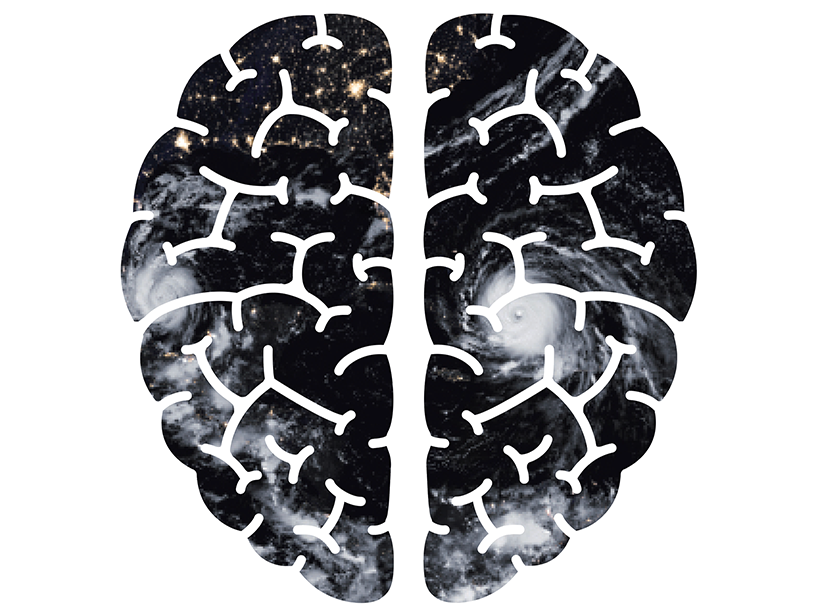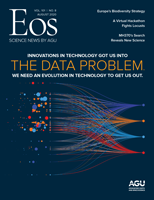The world’s need for accurate, usable predictions of atmospheric and oceanic phenomena—and their impacts—has never been greater. Climate change is affecting weather patterns and sea levels are rising, putting more and more people at risk from environmental disasters. At the same time, the quantity and quality of modeling systems and Earth observations—from satellite platforms, cell phones, connected vehicles, and many other sources—are increasing dramatically, offering a deluge of data so rich that only automated intelligent systems can fully exploit them.
Improving society’s long-term sustainability with respect to limited environmental resources while ensuring health and safety is a “wicked problem,” a term coined to describe complex real-world challenges that have severe societal consequences, cannot be studied by trial and error, and do not have clear-cut solutions. Addressing this wicked problem effectively will require new artificial intelligence (AI) methods for knowledge discovery and prediction driven by convergent collaborations across multiple sectors involved in research and enterprise.
Collaborating to Tap AI’s Potential
Currently, less than 5% of available environmental observational data are used in numerical models of Earth systems. Better models that leverage additional data are essential to improving our understanding of and ability to predict atmospheric and oceanic phenomena and their impacts, as well as to assist individuals, businesses, and governments in making better decisions to reduce harm to people, livelihoods, ecosystems, and economies.
Artificial intelligence is poised to help us harness the power of the big-data frontier by exploiting untapped environmental observations and enhancing Earth system modeling in cost-effective ways.
AI has demonstrated value throughout the observing, predicting, and impact modeling process, from preprocessing to postprocessing and improving forecasts. And with recent computational hardware innovations like graphics processing units (GPUs) and tensor processing units, as well as innovations in AI methods themselves, AI is poised to help us harness the power of the big-data frontier by exploiting untapped environmental observations and enhancing Earth system modeling in cost-effective ways.
Developing AI approaches that revolutionize our understanding of and ability to predict a wide range of environmental phenomena accurately, and that address society’s needs in the process, calls for a convergent effort across research and operational sectors. Each sector provides unique expertise, resources, and viewpoints that when deeply collaborating, can result in synergistic and substantial progress.
Broadly speaking, academia provides rich expertise and research programs that with funding from government or industry can sustain their focus on a problem for many years. Academia also trains new generations of scientists, engineers, and policy makers. Both industry and government benefit when students develop appropriate interdisciplinary knowledge and skills and gain experience with hands-on problem-solving.
To achieve environmental and public health goals, governments develop and enforce laws, policies, and regulations informed by environmental sciences. They provide long-term funding for research and development in science deemed essential to the public interest, and coordination at a scale otherwise unachievable. Governments are uniquely able to deploy large-scale, long-term operational environmental sensing systems such as radar, satellite, and buoy networks. Within the U.S. weather enterprise, the federal government also employs and trains forecasters and has the primary responsibility to issue watches and warnings.
The private sector has a wide reach and a profit motive to rapidly develop and implement new technology that can help people, organizations, and governments make better decisions. The private sector can often move more quickly and with more flexibility than other sectors, which can lead to faster adaptation. However, this agility is often driven by quarterly financial reports, which can make it difficult to devote internal resources to lengthy research projects that may take years to mature. Partnering with academia and government allows industry to identify problems of high practical value, to fund and guide external research and development, and to adopt resulting products that prove valuable and widely useful. Many private companies can also offer collaborators access to unique data and computational resources.
Multinational companies like IBM and Google are deeply ingrained in nearly every industry and have global perspectives on what environmental science information is needed and actionable, on what timescales, as well as on how this information can be distributed efficiently to the media, the public, or individual clients. These companies typically focus on simplicity and pragmatism, cost–benefit ratios, data latency, user experience, and maintainability more than academia and government do. Injecting this perspective into academic and government research and development helps ensure that high-value knowledge is developed and that methods, software, and algorithms are suitable for quick and effective use, including in commercial tools and industry-specific decision platforms. New types of deep collaboration have the potential to accelerate such research-to-operations transitions.
Trustworthy AI for Environmental Sciences
Realizing the full potential of AI to yield improved understanding and predictions of environ-mental phenomena requires convergent research to develop methods that earn the trust of decision-makers.
Realizing the full potential of AI to yield improved understanding and predictions of environmental phenomena requires convergent research to develop methods that earn the trust of decision-makers, including individuals, households, business owners and private companies, and officials at all levels of government. This trustworthiness is especially critical for extreme and high-impact environmental phenomena—ranging from tornadoes to heavy snowfall during rush hour—in which life-or-death and other protective decisions must be made quickly and reliably. Having skillful, user-trusted AI predictions of these hazards can, for example, help people decide when to take shelter or when they should (or should not) drive.

What makes environmental science AI methods trustworthy to different stakeholders varies depending on their expertise and experience, however, and it is important to understand their diverse viewpoints. Generally, physical and computer science researchers in academia pay more attention to the theoretical performance of AI-based models and less to human aspects of trust. AI researchers develop new models and score them using objective metrics. Meteorologists also use performance diagrams and case studies, examining an algorithm’s ability to reproduce observations and effects of known past events, often extreme or societally impactful events, to assess an AI model’s performance. Although AI researchers generally evaluate new models in a research setting, operational meteorologists care about what additional guidance value and physical consistency the algorithm provides in comparison with the other sources of information available to them.
Definitions and metrics for assessing reliable and trustworthy methods can be very different for private industry and government. Government forecasters may prioritize the reliability of AI techniques across weather regimes, for example, whereas private industry is incentivized to ensure that products are tailored to specific clients, with client needs driving the measures of trustworthiness.
By working across sectors and disciplines, the applied needs of end users in government and industry drive the development of new fundamental tools and techniques. Academics have developed tools such as explainable AI, which enables researchers to dive into the black box of machine learning methods and highlight what the models have learned, as well as interpretation and visualization techniques. But these tools have most often been tested on novices or on high-level users, such as other researchers, rather than on decision-making end users in government and industry. Critical end user feedback should help clarify design choices and priorities for future explainable AI systems.
Developing AI tools that earn the trust of all types of end users requires fundamental research on their different needs and perceptions. Identifying these varying needs and learning more about the dynamics of communicating model results and uncertainty, as well as about users’ risk perceptions and trust in AI, are essential to the success of AI integration across disciplines and sectors.
Cross-Sector Collaboration in Action
Integrative approaches have already proven successful as force multipliers in a variety of efforts.
This collaboration highlighted the need to work closely with end users to develop AI that they consider trustworthy.
In the U.S. Great Plains, hailstorms cause significant property damage each year. The University of Oklahoma collaborated with the U.S. National Oceanic and Atmospheric Administration’s (NOAA) Storm Prediction Center (SPC) to operationalize AI hail forecasting, producing hail forecasts 12–36 hours in advance. Operational forecasters (the meteorologists who produce weather reports like those seen on the news) considered the early AI-generated hailstorm probabilities produced by this system to be too high compared with forecasts traditionally issued by NOAA’s SPC. As a consequence, the AI forecasts were rethought and reformulated to produce probabilistic forecasts that were more in line with what human forecasters expected. This collaboration highlighted the need to work closely with end users to develop AI that they consider trustworthy.
In a collaboration among academic organizations, federal and state agencies, and the private sector, Texas A&M University–Corpus Christi created an operational AI-based forecasting system to help save sea turtles that found themselves in cold water along the Texas coastline. Strong cold fronts can decrease water temperatures quickly in coastal bays and lagunas. As a result, thousands of threatened and endangered sea turtles can become lethargic and require rescue to survive. AI-based water temperature predictions allow managers to anticipate impacts on sea turtles and save most of them by mobilizing resources, gathering and organizing volunteers, diverting watercraft, and interrupting other coastal activities such as shipping. By developing a reliable AI method through collaborations and agreements among the relevant federal, state, and local governments and the private sector, researchers have significantly reduced sea turtle deaths.
On the other side of the world, Google is collaborating with the government of India to provide end-to-end flood forecasts, including AI-based precipitation forecasting and hydrological and inundation modeling. A partnership between the Indian Central Water Commission and Google Crisis Response delivers alerts. When AI is integrated into the warning system, these alerts are more personalized to individual users and their specific locations and needs. More than 1.5 million alerts were issued in 2019, and there are plans to expand coverage tenfold in 2020.
AI approaches can also make hyperlocal weather forecasts accessible to more regions around the world. In a multiyear effort, IBM worked with the National Center for Atmospheric Research (NCAR) and the American technology company Nvidia to optimize NCAR’s state-of-the-art Model for Prediction Across Scales (MPAS) weather model to run on a GPU-equipped POWER9 supercomputer. IBM also worked with the University of Washington to develop AI methods to clean and correct millions of pressure measurements gathered from opted-in cell phone users so the measurements could be assimilated into the model. The resulting IBM Global High-Resolution Forecast System (IBM GRAF) runs hourly and produces forecasts at 3-kilometer resolution. This type of high-resolution, rapidly updating forecast was previously available only in industrialized countries but is now available to consumers and businesses around the world, including more than 300 million users of the Weather Channel mobile app.
Although some of these collaborations are just beginning, they highlight the ability of convergent multisector research to create trustworthy AI, enabling improved understanding and prediction of a broad range of environmental phenomena. These tools will be useful to decision makers for years to come, helping improve the sustainability and safety of our world.
Acknowledgments
The views expressed here are those of the authors and do not necessarily represent those of their employers, NOAA, or the U.S. government.
Author Information
Amy McGovern ([email protected]), University of Oklahoma, Norman; Ann Bostrom, University of Washington, Seattle; Imme Ebert-Uphoff, Colorado State University, Fort Collins; Ruoying He, North Carolina State University, Raleigh; Chris Thorncroft, University at Albany, Albany, N.Y.; Philippe Tissot, Texas A&M University–Corpus Christi; Sid Boukabara, National Oceanic and Atmospheric Administration, College Park, Md.; Julie Demuth and David John Gagne II, National Center for Atmospheric Research, Boulder, Colo.; Jason Hickey, Google Research, Mountain View, Calif.; and John K. Williams, The Weather Company, an IBM Business, Andover, Mass.
Citation:
McGovern, A.,Bostrom, A.,Ebert-Uphoff, I.,He, R.,Thorncroft, C.,Tissot, P.,Boukabara, S.,Demuth, J.,Gagne II, D. J.,Hickey, J., and Williams, J. K. (2020), Weathering environmental change through advances in AI, Eos, 101, https://doi.org/10.1029/2020EO147065. Published on 28 July 2020.
Text © 2020. The authors. CC BY-NC-ND 3.0
Except where otherwise noted, images are subject to copyright. Any reuse without express permission from the copyright owner is prohibited.


